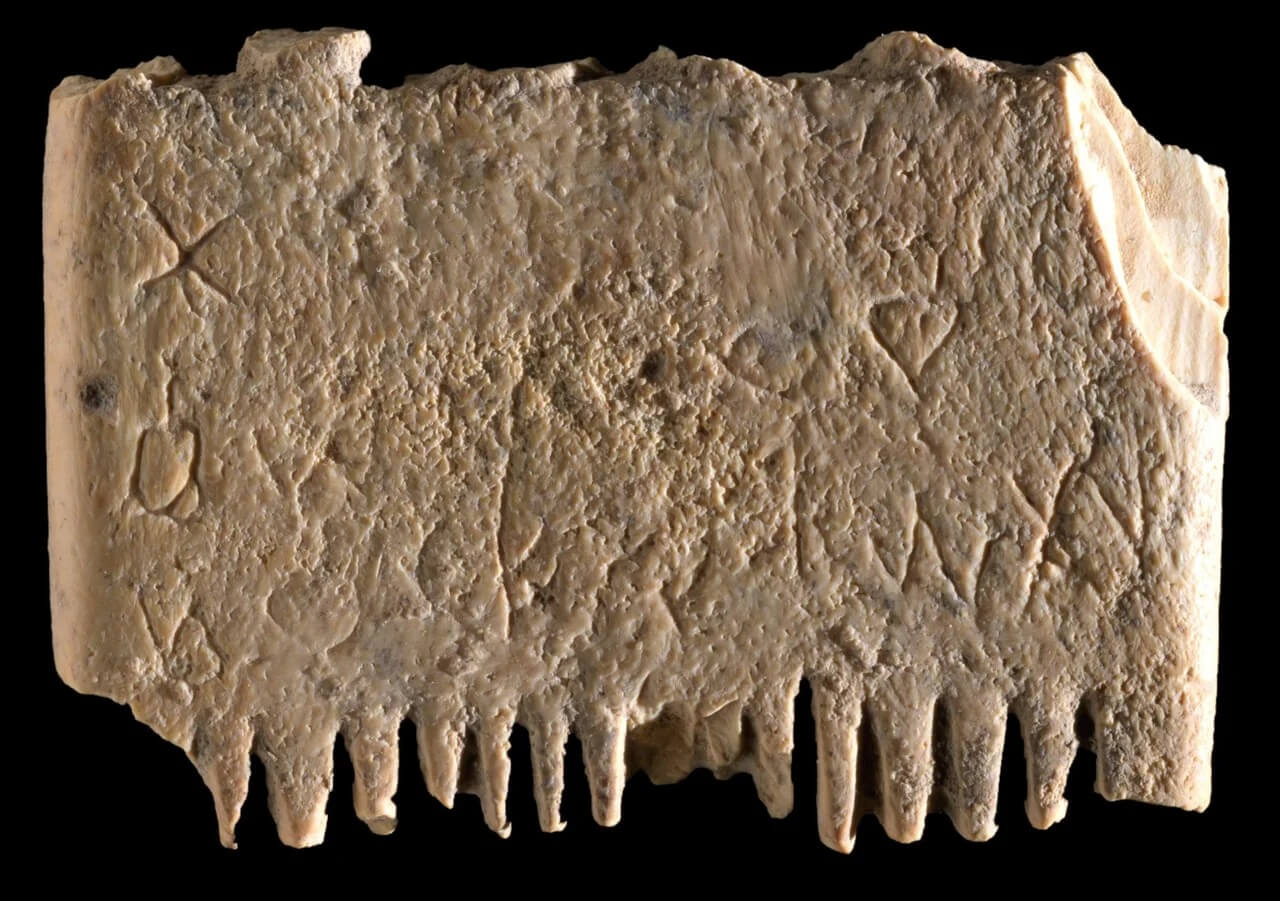Israeli archaeologists find first whole sentence written in Canaanite. On a lice comb
The earliest sentence found in Israel petitions the gods, but not to rain down good fortune or extirpate the foe

The ivory comb Photo by Dafna Gazit / Israel Antiquities Authority
This article originally appeared on Haaretz, and was reprinted here with permission. Sign up here to get Haaretz’s free Daily Brief newsletter delivered to your inbox.
“All the dust of the land became lice throughout all the land of Egypt” Exodus 8:16.
How much truth there is in the Exodus story is unclear; after all, in some translations of the Bible, the lice are flies. But we can be confident that lice were a perennial plague in biblical times, as they are to this day. We can know this because Israeli archaeologists have found a Canaanite lice comb made of elephant ivory around 3,700 years ago.
Found in 2017 in the biblical city of Lachish, the artifact joins the pantheon of ancient combs assumed to be for lice that have been found up and down the Holy Land. But this one is different.
This one bears the earliest sentence ever found in Israel, seven words in the world’s first alphabet, archaic proto-Canaanite: “May this tusk root out the lice of the hair and the beard.”
And we almost never knew. Almost four millennia after an elephant in Africa died and its tusk was fashioned into a tiny comb, the writing had become almost invisible.
The comb was unearthed and studied by researchers from the Hebrew University of Jerusalem, as well as from Southern Adventist University and Lipscomb University, both in Tennessee. The project was directed by professors Yosef Garfinkel, Michael Hasel and Martin Klingbeil, and the comb was cleaned and preserved by Miriam Lavi.
But the exhortation was noticed only this year by research associate Madeleine Mumcuoglu at Hebrew University. The writing was deciphered by semitic epigraphist Daniel Vainstub of Ben-Gurion University in Be’er Sheva. Their findings were published in the Jerusalem Journal of Archaeology.
“The whole thing is just 3 centimeters [1.2 inches] long and each letter is about 2 to 3 millimeters in size, and they were very shallowly incised,” Garfinkel says. “Under ordinary light the inscription wasn’t visible. But after six years it was examined again, maybe thanks to light from the side – and suddenly the inscription was observed.”
The inscribed comb has six big teeth on one side, to untangle hair or a beard, and 14 finer teeth on the other side that could snag the parasites and their eggs, aka nits, Mumcuoglu reported in 2008. All the teeth were broken in antiquity and the middle of the comb became eroded, maybe because it had been gripped tightly while being dragged through the offending locks.
The source material, tusk, was determined through analysis by Prof. Rivka Rabinovich of Hebrew University and Prof. Yuval Goren of Ben-Gurion University. Who might have owned an artifact like that in the Bronze Age?
Then as now, ivory was a luxury item. Earlier this year archaeologists excavating in Jerusalem found small ivory panels that would have adorned expensive, possibly royal, furniture.
The ivory for the comb was likely imported from Egypt, suggesting that the infested owner was wealthy, Garfinkel says. “It would have been like a diamond today, a crème de la crème luxury item. Others likely had lice combs too, but made of wood that would have decayed,” he says, adding that the ivory, being bone, weathered the ages.
Other lice combs have been found at Lachish and throughout Canaan. Twenty were found in a just one Middle Bronze Age cemetery in Jericho, made of wood. Another such site is ancient Jerusalem, including in a Second Temple-period house on Mount Zion, Prof. Shimon Gibson says. None until the current one bore exhortations to divine powers against parasitic affliction, but given the belated nature of the inscription’s discovery, Garfinkel suggests that other combs deserve reexamination.
And yes, the scientists found a dead Canaanite louse in the comb, on the second tooth, they report, though they qualify: “The climatic conditions of Lachish, however, did not allow preservation of whole head lice but only of the outer chitin membrane of a first or second nymph stage head louse.” They even tried to extract DNA from the corpse for genomic analysis, but it didn’t work, Garfinkel says.
To be clear, this is far from the first proto-Canaanite inscription found in Israel: 10 have been found just at Lachish, a major Canaanite city-state from the second millennium B.C.E., the Bronze Age, to the early Hellenistic period. Writing at Lachish is “nicely attested” from various periods, notes the renowned epigrapher Christopher Rollston of George Washington University in Washington, D.C., (who was not involved in this research). But this is the first actual Canaanite sentence, says Vainstub.
The inscription also contains the earliest known representation of the letter “sin”, which in hebrew today is pronounced the same as “samekh”, or the letter “s” but then had a different sound, Vainstub explains. Today the ancient sin persists only among some peoples in southern Arabia, he adds.
How did he interpret the words for louse, hair and beard? Canaanite has significant similarities with the most ancient stratum of biblical-era Hebrew, for one thing. “The first word is the root natash which serves like in Hebrew – to root out,” he explains. The Canaanite word for hair is se’ar, the same as in all semitic languages. Beard is zakat, similar to the Hebrew zakan. Though at about 3,700 years old, the Canaanite comb predates the Israelites’ arrival by centuries.
Rollston confirms that in his opinion, the writing is indeed early Canaanite script, adding: “This is a wonderful inscription, both because of the content of the inscription as well as the object upon which it is written: a comb. And it also reminds us yet again that pesky little insects such as gnats and flies (mentioned as the third and fourth plagues in Exodus 8) and lice (mentioned in this new inscription) have been problems since time immemorial.”
Proto-Canaanite is not the earliest form of writing. Proto-writing emerged in Mesopotamia and/or ancient Egypt at the dawn of the Bronze Age; also perhaps in Harappa in the Indian subcontinent. Small clay tokens were incised with an image, for instance a cow, and marks that may have denoted value, name, owner – we really don’t know. Then cuneiform emerged in Mesopotamia and hieroglyphics in Egypt, which involved scribes learning thousands of symbols, Garfinkel notes.
The thinking is, that’s why Canaanites working for, or in, Egypt invented the first alphabet. The earliest examples of alphabetic writing were found at Wadi el-Hol in Egypt’s Western Desert, and at Serabit el-Khadim in southern Sinai. There the writing is called proto-Sinaitic, dating to about 3,900 years ago. Proto-Canaanite is believed to be the same system, devised to represent sounds by Canaanites who couldn’t or chose not to learn hieroglyphics.
To be clear, several inscriptions in proto-Canaanite have been found to date, including 10 in Lachish itself, but all had only isolated letters or two or three words. One vessel, the “Lachish ewer” (found in 1934), bears drawings of animals and trees, and some writing; it seems to date to the late 13th century B.C.E. A shard with letters found at Lachish came from of a pot imported from Cyprus about 3,500 years ago and inked in Canaan.
Unlike the exhortation to the god against parasites, it’s too incomplete to hazard a guess at what it said. Other examples of proto-Canaanite writing were found at Gezer and Shechem.
Asked if the comb could cast light on literacy in the Bronze Age, Garfinkel surmises that at first, probably only elites could read and write. But in time, the simplicity of the alphabet compared with, say, hieroglyphics and cuneiform, made reading and writing accessible to all, he says.
“Today we all use alphabets, in Hebrew and Arabic and Arabic and French – the whole world. Intellectually it’s the most important contribution of the Canaanite culture to human history,” Garfinkel says.
Rollston adds that in the ancient Near East, powerful and wealthy elites would commission scribes to write on prestige objects, noting the Kefar Veradim Bronze Bowl from the Galilee, and an inscribed bronze dagger from Lachish also from the Canaanite period. But that doesn’t mean the comb inscription demonstrates widespread literacy among ordinary folk.
“In other words, it would be a real stretch for someone to use this inscription to try to suggest that farmers, blacksmiths and potters were literate. They weren’t,” he says.
It seems the working class would remain unlearned a while longer. Rollston notes the writing of Second Temple Jewish teacher Ben Sira (around. 180 B.C.E.): “The scribe’s wisdom increases wisdom; whoever is free from toil can become wise” – Ben Sira 38:24-29:11. The sage goes on to extol workers’ vital role in society while stressing that they had no role in government.
Later, proto-Canaanite would inspire the emergence of other alphabets, including this one. Yes, our letters stem from lice-infested peoples of the Levant.
A message from our Publisher & CEO Rachel Fishman Feddersen

I hope you appreciated this article. Before you go, I’d like to ask you to please support the Forward’s award-winning, nonprofit journalism so that we can be prepared for whatever news 2025 brings.
At a time when other newsrooms are closing or cutting back, the Forward has removed its paywall and invested additional resources to report on the ground from Israel and around the U.S. on the impact of the war, rising antisemitism and polarized discourse.
Readers like you make it all possible. Support our work by becoming a Forward Member and connect with our journalism and your community.
— Rachel Fishman Feddersen, Publisher and CEO


























